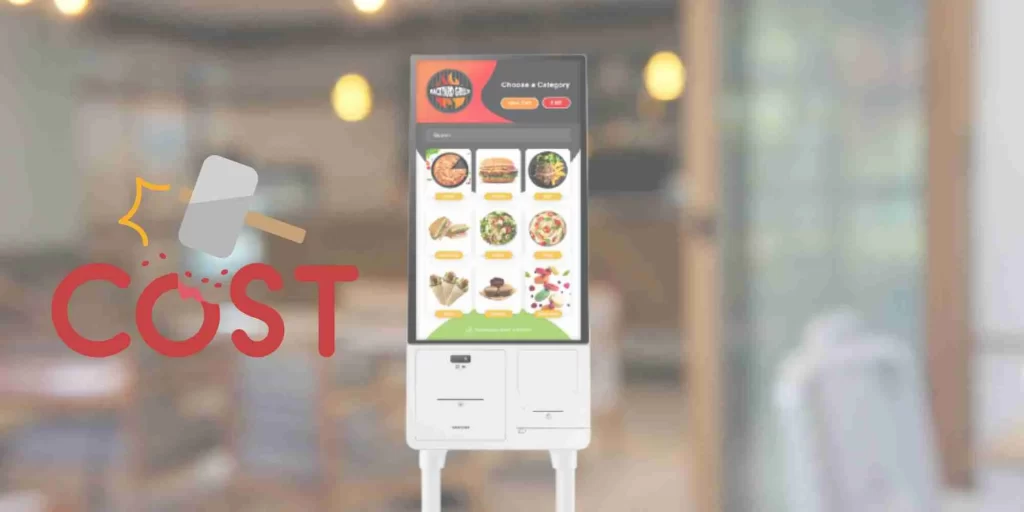In the digitally-driven world of the restaurant industry, self-serve kiosks have emerged as a transformative solution, offering a blend of efficiency, customer satisfaction, and technological advancement. However, for restaurant owners contemplating this investment, understanding the nuanced balance between the cost and benefits of self-serve kiosks is crucial.
This guide aims to provide a detailed evaluation, helping owners make informed decisions and optimize the return on their investment.
Understanding the Costs of Self-Serve Kiosks

Investing in self-serve kiosks involves several components, and it’s essential to consider each to gauge the overall cost.
Must Read – How To Justify The Cost of Self-Ordering Kiosks
- Initial Investment in Hardware and Software
The cornerstone of a self-service kiosk system lies in its hardware and software components. This encompasses the physical kiosk units, which can vary from standalone structures to compact countertop models, and may also include specialized versions designed for outdoor use. The diversity in types and features of kiosks leads to a broad spectrum of pricing.
- Installation and System Integration Costs
Setting up self-serve kiosks isn’t just about placing hardware in the restaurant; it involves integrating these systems with the existing POS setup. This process is crucial for ensuring that the kiosk and POS systems work in harmony, offering a seamless experience for both customers and staff. Depending on the specific requirements, professional services might be necessary to ensure proper installation and integration, adding to the initial costs.
- Ongoing Maintenance and Support
Beyond the initial setup, self-serve kiosks demand continuous attention to function efficiently. This includes routine maintenance, timely software updates, and access to reliable technical support to address any operational hitches promptly. To mitigate unexpected costs and ensure uninterrupted service, restaurant owners might consider investing in warranty options for their kiosk systems. While these warranties represent an additional expense, they can provide peace of mind and protection against unforeseen issues.
Must Read – The Pros and Cons of Implementing a Restaurant Kiosk
Quantifying the Benefits of Self-Serve Kiosks

While the costs are quantifiable, the benefits, although sometimes intangible, can significantly outweigh the initial investment.
- Minimizing Wait Times
The length of wait times plays a pivotal role in a customer’s decision to dine in a restaurant. Self-serve kiosks expedite the ordering process, significantly reducing wait times. A study on checkout lines highlighted that 69% of customers find long lines extremely frustrating. By minimizing wait times, restaurants can serve more guests, leading to increased revenue.
- Offering a Contactless Dining Experience
The demand for a contactless dining experience has surged, with customers valuing both convenience and safety. Self-serve kiosks facilitate a seamless ordering and payment process, supporting various payment methods and ensuring the customer’s payment card remains in their possession. Notably, nearly 75% of customers express a preference for features like bill-splitting on self-payment devices. Moreover, 61% of consumers now opt for businesses that offer contactless payment options, underscoring the significance of kiosks in today’s market.
- Enhancing Order Accuracy
The precision of orders is drastically improved with self-service kiosks, as customers directly input their orders, reducing the chance of miscommunication. This direct interaction is especially beneficial for customized orders, ensuring every detail is accurately captured. This accuracy not only enhances customer satisfaction but also streamlines kitchen operations. Interestingly, 47% of diners are willing to use self-service technology for order customization.
- Implementing Effective Upselling Techniques
Kiosks excel in subtly encouraging customers to increase their spend per visit. Unlike human upselling, which can sometimes be perceived as intrusive, kiosks offer suggestions in a manner that customers tend to view as helpful information. This leads to a significant increase in order value, with self-service orders being up to 30% higher than those taken by staff.
- Catering to Customer Preferences in Ordering and Payment
A majority of patrons appreciate the efficiency and personalization offered by self-serve kiosks. These systems often greet users with attractive displays and detailed images of menu items, facilitating a quicker and more informed decision-making process. The tactile interaction with touchscreens also enhances the user experience, creating positive emotions and associations with the brand. Furthermore, the reliability of kiosks, unaffected by human factors like fatigue or mood, ensures consistent service quality, especially during peak hours.
- Refining the Customer Experience
Today’s consumers seek control over their purchasing journey. Self-serve kiosks offer this autonomy, allowing patrons to ensure their orders are accurate and tailor their dining experience to their preferences. This empowerment contributes significantly to overall customer satisfaction.
- Conserving Valuable Resources
Self-serve kiosks offer a strategic solution to resource management. By automating the ordering process, staff are freed to focus on other critical aspects of restaurant operations such as food preparation, space maintenance, and customer service. This optimization of human resources leads to a more efficient operation, reducing costs and enhancing the customer experience.
Calculating the Break-Even Point
To determine when the investment in a self-ordering kiosk will start yielding a return, calculate the break-even point. Consider the total investment, including all costs, and compare it against the projected increase in revenue and cost savings. This calculation will provide a timeline for when the kiosk will pay for itself and start generating profit.
A Real-World Example: Applova’s Impact

Applova’s self-serve kiosks are a testament to the transformative power of this technology. Restaurants that have integrated Applova’s solutions have not only enhanced their operational efficiency but also reported a significant increase in average order value and customer satisfaction. The robust analytics and seamless integration with existing systems make Applova’s solutions a valuable asset, offering a clear pathway to recouping the investment and driving long-term growth.
Conclusion
In conclusion, investing in self-serve kiosks is a strategic choice that transforms restaurant operations, aligning with long-term goals of growth, efficiency, and customer satisfaction. It’s not just about the initial cost but the broader perspective of enhanced dining experiences and increased profitability. By adopting innovative solutions like Applova’s, restaurant owners can ensure their businesses stay competitive and responsive to evolving industry dynamics, turning this technology into a cornerstone of their success.












Leave a Reply